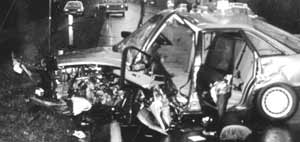Germanys trauma care system facing new changes and challenges
Residents entering a trauma specialty would have three years of general surgery and three years of orthopaedic surgery training.
Editor’s note: This is the first installment in a series of articles profiling different trauma care systems throughout the world.
German orthopaedic trauma care has evolved and remains innovative, flexible and responsive, proponents say. However, Germany’s medical education system is undergoing changes, which may affect the general management of trauma patients.
|
Courtesy of Christian Krettek |
Orthopaedic trauma surgeon Hans-Christophe Pape, MD, of the University of Pittsburgh Medical Center, described more of the notable recent changes and then offered a brief history of German trauma care at the Orthopaedic Trauma Association 21st Annual Meeting here. Pape was formerly at Hannover Medical School in Hannover, Germany,
Winds of change
Charles M. Court-Brown, MD, the symposium’s moderator, asked Pape to describe the possible changes to the German-Swiss-Austrian system, whose trauma surgeons have traditionally handled orthopaedics, neurosurgery and abdominal trauma.
In the current system, trauma specialists take a six-year surgical training program, plus two or three years of orthopaedic surgical training. Under the proposed changes, surgical residents would have three years of general surgery and three years of orthopaedic surgery, “so after six years the general education will be finished,” Pape said.
“The most important advantage of the old system was you would have people who entered the residency knowing that they want to do trauma and that they want to treat acute injury, rather than perform elective surgery,” he said.
Otto von Bismarck, the First Imperial Chancellor of Germany, founded the German insurance system in 1884. Germany’s Social Security System covers health insurance, pension insurance, accidents and senior citizen care.
Pape cited Viennese surgeon Lorenz Böhler, MD, considered the first surgeon to standardize orthopaedic trauma surgery. During World War I, Böhler used conservative measures but got good results treating gunshot fracture victims
Böhler was the first surgeon to call for orthopaedic trauma surgeons to serve as hospital trauma leaders. Today, orthopaedic trauma surgeons are also responsible for patient rehabilitation, Pape said. However, rehabilitation costs are a major concern.
Pape described a paraplegic 61-year-old farmer who underwent extensive rehabilitation and received special equipment that helps him work. The “drawback,” Pape said, was the $1.35 million cost of the farmer’s medical treatment. “We are curious whether this will be able to be kept up in the future,” he said.
Still, traffic accidents are the largest trauma-related problem in Germany, Pape said. Surprisingly, the death rate from auto accidents on Germany’s high-speed Autobahn is 37 per 1000 accidents, but the death rate on the nation’s rural roads is greater: 49 per 1000 accidents, Pape said.
The cause? German reunification in 1989 introduced faster and more modern cars to antiquated roads in the former East Germany, which resulted in more accidents. However, the fatality rate has decreased gradually since the late 1980s as road crews have updated and improved the country’s “backroads,” Pape said.
Physicians to the rescue
German trauma care took another step in the 1920s and 1930s, when surgeon Martin Kirschner called for physicians going to the patient at a trauma scene rather than taking the patient to the physician, Pape said. Kirschner’s vision led to a fully equipped and fully staffed mobile operating room.
|
“However, it didn’t really work because they overlooked that whenever there’s a crash on the Autobahn or some other road, there’s also a traffic jam and, as you can imagine, this mobile operating room would have trouble to get to the scene of the accident,” Pape said. “So, they quit the idea pretty quickly.”
Today, having learned from the United States, Germany relies heavily on air rescue. Pape showed one slide of a Hannover-based helicopter with one pilot, one physician and one assistant. The helicopter easily negotiated hilly, wooded terrain to rescue a motorist whose car had hit a tree.
A few years ago, 39 helicopters carried 80 physicians to the scene of a high-speed train crash near Hannover. The train had 350 passengers when it hit a bridge. In slightly more than one hour, the helicopters took patients to 23 trauma centers. Sunny, daytime conditions helped rescuers work rapidly and efficiently, Pape said.
For more information:
- Pape HC. German Trauma Delivery. International Symposium #1. Presented at the Orthopaedic Trauma Association 21st Annual Meeting. Oct. 19-22, 2005. Ottawa.
Editor’s note: In our July/August issue, Orthopaedics Today will report on some new developments in the British trauma system.

